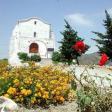| Essential Canillas Information | Local Businesses in Canillas | Canillas Bars & Restaurants | Canillas Photos |
Canillas de Albaida History
 Considering that “albaida” means “white” in Arabic, the name of this village could not be more appropriate. Seen from a certain distance, the white of its buildings stands out brilliantly against the knoll on which the village sits.On the north, the municipality extends to the summits of the Sierra Almijara range, on the border of the province of Granada, and southward, to near Daimalos, part of the municipal territory of Arenas.
Considering that “albaida” means “white” in Arabic, the name of this village could not be more appropriate. Seen from a certain distance, the white of its buildings stands out brilliantly against the knoll on which the village sits.On the north, the municipality extends to the summits of the Sierra Almijara range, on the border of the province of Granada, and southward, to near Daimalos, part of the municipal territory of Arenas.
The hills of Secanillo and Cuevas rise near the village as precursors of the mountain landscape. With an altitude of about 800 metres, they point the way to the lofty (more than 1,600 metres) cliffs of Chapa, Albucaz and Carneros, which are surrounded by ravines and seasonal watercourses to which a few pine groves cling.As the terrain levels out somewhat and the water torrents become streams such as La Cueva, Turvilla and Ciguilias the countryside becomes covered with cottonwoods, poplars and oleanders. In places, along the now-tranquil waterways, this vegetation creates some exceptionally beautiful scenes.
One such place is La Fábrica, where the La Cueva and Turvilla streams join in an area close to the village that is much visited by the people of the region who avail themselves of the camping facilities there.The southern side of this territory is for the most part more typical of the landscape of La Axarquía. Vineyards and almond and olive trees begin to show up on the hills, and in the valleys near the village, where water is abundant, some irrigated cropland appears.The locality very probably originated in the thirteenth century when it was a farm district belonging to Vélez Málaga.
According to chronicles, the name (Albaida, which means white) apparently has more to do with the colour of the flowers that adorned the setting in that era than with the houses, although nowadays it is associated with the whitewash of its dwellings.After the conquest of Vélez Málaga by the Catholic Monarchs in 1487 Canillas de Albaida capitulated to the Christian troops but that did not keep it from joining the sixteenth century Moorish rebellion, which brought upon it the same fate that befell the other surrounding villages after defeat at the battle of Peñón de Frigiliana, a thoroughly documented historical event.
 |
 |
 |
| Surface Area: | 33.2 square kilometres |
| Population: | about 800 |
| What the natives are called: | Canilleros |
| Monuments: | the Nuestra Señora de la Expectación church and the hermitages of Santa Ana and San Antón. |
| Geographical Location: | in the La Axarquía region, 50 kilometres from Málaga and only 2.5 kilometres from Cómpeta. The village is about 580 metres above sea level. The annual average rainfall in the area is 670 litres per square metre and the average temperature is 17º C. |
| Tourist Information: | Town Hall, Plaza Generalísimo, 8 (29755). |
| Telephone: |
952 553 006; Fax: 952 553 100 |



















